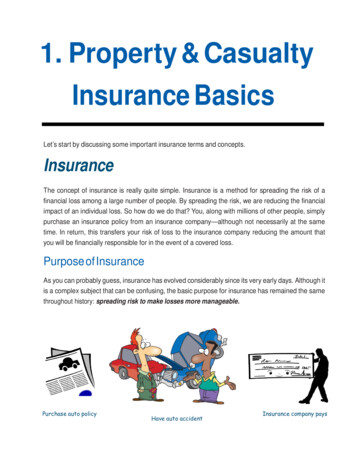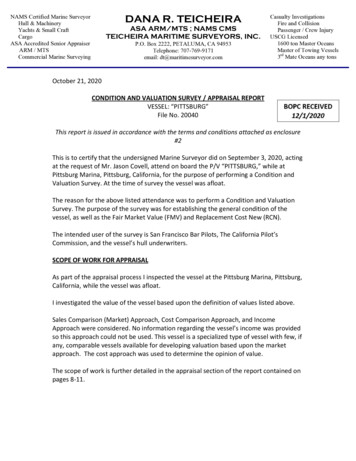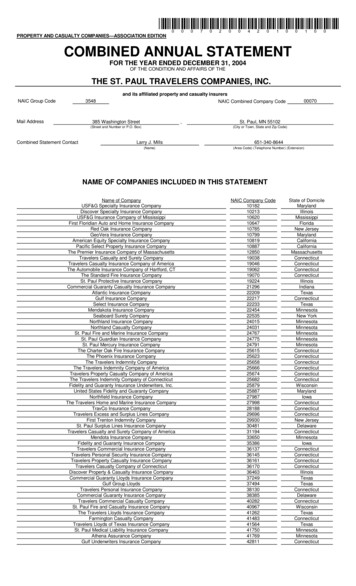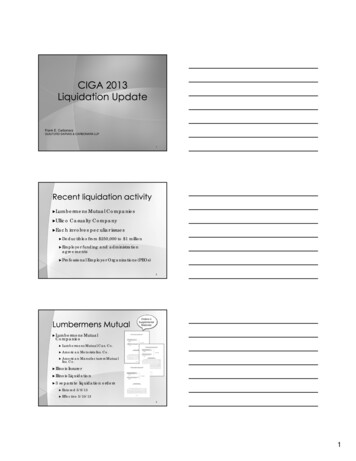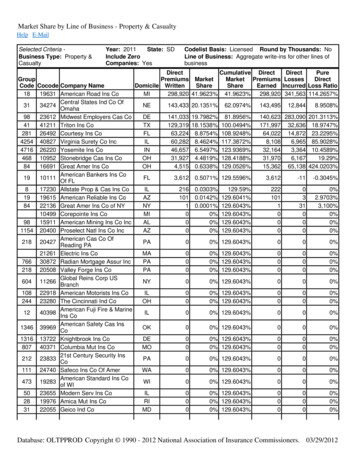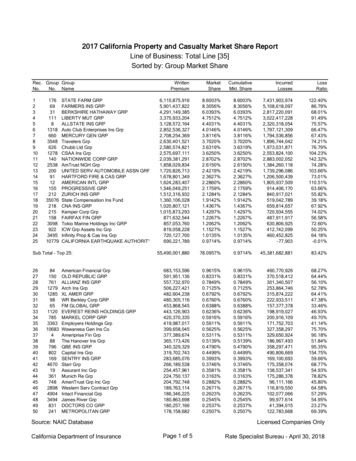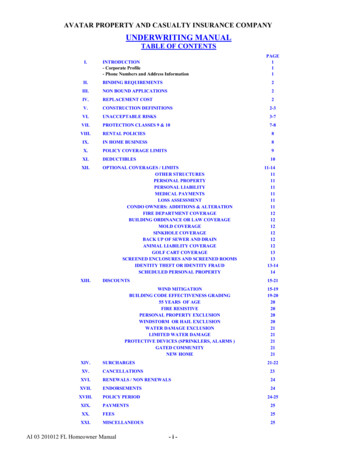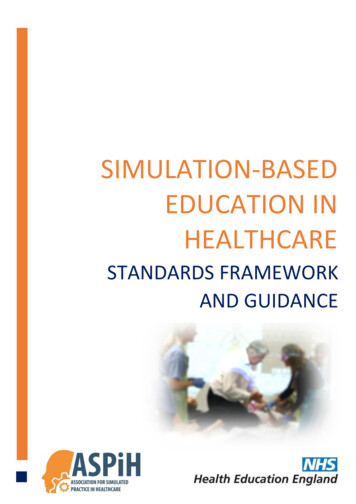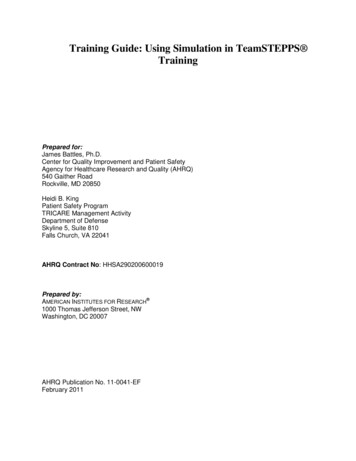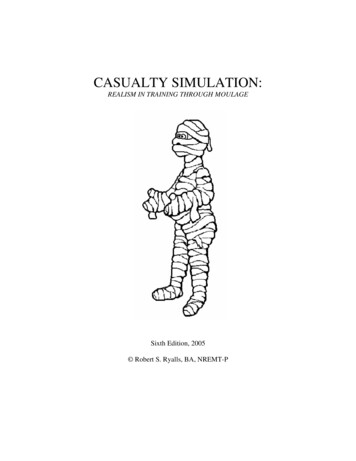
Transcription
CASUALTY SIMULATION:REALISM IN TRAINING THROUGH MOULAGESixth Edition, 2005 Robert S. Ryalls, BA, NREMT-P
TABLE OF CONTENTSTABLE OF CONTENTS2SPECIAL RECOGNITION3INTRODUCTIONS4DEFINITION4LANGUAGE & TOOLS OF THE TRADE4FOUR COMPONENTS OF CASUALTY SIMULATION5PLANNING5MOULAGE7TYPES OF INJURIES8SPECIAL EFFECTS12STAGING14SYMPTOMATIC ACTING15DIAGNOSTIC SIGNS19APPENDIXADVANCED CASUALTY INJURY LISTS22INJURIES FOR A MASS CASUALTY DRILL28CONTENTS OF A BASIC MOULAGE KIT31SAMPLE “THANK YOU” LETTER FOR “VICTIMS”33MOULAGE WORKSHEET35SOME SAMPLES OF MOULAGE41REFERENCE MATERIAL462
SPECIAL RECOGNITIONThis is the sixth edition of this manual on "Casualty Simulation: Realism inTraining through Moulage". Over the past 33 years, I have had the unique opportunity tohave participated in several large scale training exercises as well as multiple BTLS, EMTand Paramedic final practical exams. These opportunities deepened my desire to bringthe techniques of moulage to the printed page so that others might learn this valuableskill. This goal was reached in 1986 with the first edition of this manual. My hope isthat it helps other instructors to enhance their students learning experiences andknowledge in providing effective emergency medical care in the pre-hospital setting.I would like to acknowledge the continued support and encouragement of severalindividuals, shown me through the years as I practiced my "moulage magic".The late Russell L. Lowry, Jr., Emergency Services Coordinator for James CityCounty, a terrific boss who always enjoyed getting his hands "dirty" with me.HMC Sandra Gurnik, USN, former ATLS instructor at the Uniformed ServicesUniversity of the Health Sciences, Bethesda, MD who served as my initial mentor duringmy preceptor-ship in Moulage.Marge Dolan, of Image Perspectives, who enhanced my abilities as a “moulageartist” through her innovative techniques which enable the injury to retain its’ realisticappearance and stand up to the repeated manipulations in a training environment.Captain A.G. Pollard, NC, USNR, my former Commanding Officer or "Skipper"who spearheaded the large scale "RESPONSE" exercises where casualty simulation tookon a new meaning for the hundreds of naval reservists who serve in the medical unitsthroughout the Norfolk, VA area.To my children, Amber and Nathan, who willingly gave up their dad on drillweekends and during the week when I had to "make-up" some casualties for a drill or aclass. As they grew older, they would sometimes join me in preparing the victims.Finally, to my wife, Lorraine, who has indulged my many faults and shortcomingsthrough the years when I had to teach a moulage class or practice my "madness" oncasualties for just one more drill. Her love and support is what makes my life trulyworthwhile.3
INTRODUCTION: CASUALTY SIMULATIONIf you have been involved in EMS for any length of time, then you should havebeen involved in at least one "Disaster Drill". Depending on the amount of time spent inpreparing the victims', you may have felt that the drill itself was a real disaster.Consider arriving on the scene to find a victim' who is supposed to have major traumaticinjuries, a decreasing level of consciousness and in shock but is lying there on the ground the picture of perfect health, laughing and wearing a tag which describes their injuries'.What would be your reaction?Disgust! Anger! Disappointment!Of course, and rightly so. You were trained to treatinjuries, which you can "see, feel or smell." Whyshould a drill be any different? Realism in teachingthe fundamentals are necessary if the instructor wantsto trigger the desired response. Only through plannedrealistic exercises can EMS personnel be conditionedto function in an emergency situation.Casualty simulation is an essential part of thesetraining exercises. That is the purpose of this manualon Casualty Simulation; to aid you in becoming adeptat creating an effective illusion to aid in that realistictraining experience.DEFINITION:According to Webster's dictionary, Moulage is defined as the science or practiceof making a mold in some plastic substance. For the purposes of this course, moulagecan be defined as the art of casualty simulation. Moulage is considered an art because ittakes imagination and creativity to produce a simulated casualty. Moulage isaccomplished by wound simulation through the use of make-up and clay (or wax) ormake-up and prefabricated devices.LANGUAGE AND TOOLS OF THE TRADE:The items listed below, when combined, will give you the components of a basicmoulage kit.Adhesive: a sticky substance used to hold the moulage device or modeling substance inplace. (spirit gum, tincture of benzoin, liquid latex)Blood powder: a commercial product which, when mixed with liquid (water, liquidstarch, glycerin, etc), simulates human blood.***CAUTION** Blood mixtures will stain hair and clothing.DO NOT GET NEAR EYES.2
Brushes: artist type can be used for application of grease paints or powderCharcoal powder: for use in the moulage of burnsCold Cream: a commercial product used to protect the skin under make-up and an aid inthe removal of makeup.Combs: used in creation of special effectsCotton: for make-up application and removal; special effectsCotton tipped applicators: for make-up applicationEffects Gel: a gelatin-based product (Ben Nye) that is solid when cold but becomeliquid when warm; reusable. Comes in three colors: Scar, Flesh, BloodEffects Gel Applicator: equipment that applies the effect gelEffects Wheel: a commercial Ben Nye product which includes several colors in onecontainerFacial masque: used in creation of special effects, 3rd degree burnsForeign bodies of impaled objects/open fractures: used in creation of special effects(bone fragments, sticks, pieces of wood, pieces of metal, knife handle, shell fragments,plexiglass, etc.)Glycerin: a colorless syrupy liquid used in many lotions as a base. In moulage work,the glycerin is used alone or mixed with various substances for a variety of effects.K-Y Jelly or Vaseline: used in creating blisters for burns. (Vaseline is also used in theformula for making moulage wax)Palette knife: a thin blade, blunt edged flexible instrument with a metal blade andwooden handle. Used when working with a modeling substance and for blendingtheatrical make-up.Modeling substance: any material (in a variety of flesh tones) that can be molded orshaped to simulate human skin and tissue when creating artificial injuries.modeling clayplastalenemorticians waxderma-waxSponges: for use in applying and blending make-upstippling sponges make-up sponges3
Theatrical Make-up: a type of commercial make-up used to add color to the simulatedwound. Colors used most often are the following:clownwhitebright redbright bluedark bluelight bluegrey violetblackbrownyellowflesh tones: ivorylight beigedark beigelight tandark tanTissue paper: used in creating blistersTongue depressors: for use in place of a palette knife to work with modeling substanceand makeup.Additional items: items that are very usefulpaper towelsbandage scissorsplastic spray bottlesyringestube gauzeprepared blood mixturessmall mirrorhand cleaner (LAVA or Goo-Gone are both excellent)Optional items:Prefabricated Moulage Devices: There are occasions when the moulage teammembers will not have the time, resources, or expertise to do a through moulage creationand must, instead, rely on prefabricated stick-on plastic or strap-on rubber devices forwound simulation. These devices are life-sized, with bone and flesh shown in relief onthe surface. Many of the strap-on devices have plastic tubing installed in them. Thetubing, when connected to a hand-held pump and reservoir can simulate bleeding in thewound.Device: Strap-on:Device: Stick-on:a rubber device which, when properly applied, creates anartificial wound.a prefabricated device sculptured from thin plastic which,when properly applied to the skin with adhesive andcolored with cosmetics, simulates a wound.Advantages:1. The materials are easily maintained with soap and water.2. The devices can be enhanced with makeup to look even more realistic.Disadvantages:1. The skin coloring and texture of the strap-on devices will only simulatethat of a white male.2. The strap-on devices are uncomfortable and warm to the wearer.3. The strap-on devices are difficult to maintain. There are no replacementparts (straps).4. Some are not very realistic as far as true characteristics of wounds.4
Some samples of Strap-On Devices:FOUR COMPONENTS OF CASUALTY SIMULATION:Casualty simulation can be defined as the imitation of someone injured in sometype of accident or disaster. I believe that in order for your casualty simulation to beeffective, it must be believable. This requires some prior preparation on your part. Thefour components of an effective casualty simulation are Planning, Moulage, Stagingand Symptomatic Acting.PLANNING:Planning is the first component in the success of a casualty simulation exercise.There are many considerations to be made in this stage and a logical pattern will helpkeep you from making common mistakes.Before the Exercise1. Select someone with moulage experience as the moulage team leader.2. Allow the team leader to select his team members. (1 team member for every 6victims)3. Have planning session(s) with the moulage team leader, members and exercisecoordinator to discuss the following:a. Type of exerciseb. Date, place and time of exercisec. Number of victims to be moulagedd. Types of injuriese. Prepare the scenarios/worksheets or familiarize the team with existingones (already prepared).f. Identify time, area needed for moulage preparationg. Identify equipment not available5
Day of the Exercise1. Team leader and team members arrive earlya. Final briefing by team leader (assignments)b. Set up equipmentc. Team leader selects victims or identifies pre-selected victimsDO SELECT:1) Casualties whose physical characteristics willsimplify moulage application. (bald, existing amputation,etc.)2) Use Males for chest injuries.DO NOT:1) Use makeup on persons with obvious skin infections orabrasions.2) Use makeup on persons with known sensitivity orallergies to makeup.d. Moulage1) Ensure casualties are wearing old clothes as tears andstains are inevitable; also if casualties are being preparedfor exercise where the injuries have to be treated, tearing ofthe clothing to expose the injuries will be necessary.2) See that the casualty is in a reasonable, comfortableposition while being made up and is mot in a draft or toowarm.3) Show appreciation of the casualties cooperation andpatience by seen that he receives every assistance whilebeing made-up.e. Cleanup1) Remember:"YOUR TASK IS NOT FINISHED UNTIL THEMAKE-UP IS REMOVED"6
MOULAGE:The actual moulage application is the most exciting part of the process since itallows your imagination to have creative license, within reason of course. Remember,your "victims" injuries must appear realistic if they are going to be believable.To mix these two components together we must have a better understanding ofthe techniques used in applying moulage. These components are Blending, Feathering,and Highlighting.Blending: mixing or combining two or more types of makeup to achieve aparticular type of result.Usage: Bruise - reds and blues are blendedFeathering: smoothing the edges of modeling clay as it adheres to the skin;blending the moulage colors into the natural skin color ofthe victim.Usage: lacerations, fracturesHighlighting: darker color placed beneath a lighter color to give the impressionof depth or shadow.Usage: lacerations, fractures7
TYPES OF INJURIESThere are a wide variety of injuries which can be created utilizing the skillsdescribed in this manual. The following is just a sample of the various injuries you cancreate. More advanced injuries are included in the Appendix of this manual for yourfuture use in casualty simulation.Abrasion: the wearing away of the skin due to a friction source.To create an abrasion:1) Apply a small amount of cold cream to injury siteand blend well2) Apply red to a stippling sponge3) Lightly drag the sponge across the surface of theskin for the desired effect.Contusion (bruise): an injury produced by an impact where the skin is notbroken (lacerated)To create a contusion:1) Apply a small amount of cold cream to injury site and blendwell2) Apply red and blue to a sponge or heel of your hand.3) Blend for effect into the injury site using sponge on the heelof your hand.Wounds: are always associated with bleeding to some degree. They can beclassified as follows:1) Incised: caused by sharp instrument such as a razor, knife,or piece of glass and bleeds profusely since the blood vesselsare cleanly cut/sliced.2) Laceration: will have torn and irregular edges. Suchthings as machinery, a piece of shell or the claws of an animal causethem. As the blood vessels are torn through, they tend to bleed lessthan an8
3) Avulsion: usually characterized by (bite, tearing ofskin, etc.). This type of wound is often seen in facialinjuries due to the skin lying closely over bonystructures and they bleed profusely.4) Puncture: will have a relatively small opening but may bevery deep and are caused by sharp pointed objects (bullets, icepick, etc.)To create a wound:1) Apply a small amount of cold cream to the injury site and blend into theskin well.2) Apply a small piece of wax (modeling substance, clay, etc.) to injurysite and feather, using a palette knife.3) Make a small incision (can be straight, jagged, or puncture) in the wax.4) Highlight the inside of wound with black (to create depth)5) Apply skin tone makeup using sponge or apply red and blue to give abruised appearance.6) Sprinkle blood powder on and around wound site.7) Spray with a glycerin water mix to give the desired effect.Burns: a lesion caused by the contact of heat or fireThe state of the skin texture following a burn from any cause will dependon the degree of heat and the length of exposure. This can be shown to vary fromlight redness to a black charring as well as from dryness to oozing moisture.There is an intermediate stage where white blister formations may occurbut this does not take place if the burn has penetrated the whole skin thickness. Inextensive burns, pain and shock will be severe.9
To create a 1st degree burn: (redness)1) Apply a small amount of cold cream to the injury siteand blend into the skin well.2) Apply red and blend till desire effect is achieved.To create a 2nd degree burn: (redness & blisters)1) Apply a small amount of cold cream to the injury siteand blend into the skin well.2) Apply red as for 1st degree burn.3) Using a tongue depressor, place a small glob ofVaseline over the red area. (DO NOT SPREAD OUT)4) Tear a piece of tissue large enough to cover theVaseline.5) Place tissue over the Vaseline and feather the edges.**Note: You can use K-Y jelly in place of the Vaseline. (See Advanced Techniques forother variations of this method.)To create a 3rd degree burn: (dead tissue)1) Apply a small amount of cold cream to the injury site and blendinto the skin well.2) Apply red as for 1st degree burn.3) Apply small amount of black and blend into area.4) Apply a thin coat of facial masque and allow to dry.5) When masque is dry, gently peel thus leaving an appearance ofdead skin.6) Charcoal powder may be applied to indicate charred skin.**Note: See Advanced Techniques for other variations of this method.)Fractures: a break in the continuity of a bone.Fractures are associated with pain, swelling, and loss of function.Casualties with broken bones will suffer considerable pain and will resist anyeffort to move the broken part. Fractures of the upper arm, thigh, and hip areaccompanied by moderate shock. Shock is increased if the fracture is open or ifthere is considerable tissue damage. The two types of fractures are:10
Closed: a fracture, which does not produce an openwound in the skin. (swelling and bruising)Open: a fracture, which has an externalwound leading to the break in thebone. (swelling, wound and bleeding)To create a closed fracture:1) Apply a small amount of cold cream to the injury site and blend into the skinwell.2) Apply wax and feather edges.3) Apply read and blue to the area,4) Blend until desired effect is achieved.To create an open fracture:1) Apply a small amount of cold cream to the injury site and blend into the skinwell.2) Apply wax and feather edges.3) Apply flesh tone makeup to area and blend.4) Create wound in wax with palette knife.5) Highlight wound with black to create depth.6) Insert bone fragment into wound,7) Apply red and blue for bruising and blend as needed.8) Sprinkle blood powder in, on and around wound.9) Spray with glycerin and water mix.11
SPECIAL EFFECTS:Special effects are those techniques used for a final touch of realism. They areshock and cyanosis, perspiration, frothing, types of blood, odors and vomitus. Let'sexamine each of these special effects in a little more detail.Shock and Cyanosis:Shock is generally a temporary state of massivephysiological reaction to bodily trauma. It is usuallycharacterized by marked loss of blood pressure and thedepression of vital processes.Cyanosis is a bluish discoloration of the skin andmucous membranes resulting from inadequate oxygenation ofthe blood.To create Shock and Cyanosis:1) Apply a small amount of cold cream to face, neck, arms and hands;blend well into the skin.2) Using your hand as a palette, mix a small amount of clown white andlight/medium blue or blue grey; apply to face, neck and arms; blend intothe natural skin color of the victim.3) Apply light/medium blue to lips, ear ridges, ear lobes, nostrils, nailbeds, fingers and toes (as needed).For profound shock: add ivory/yellow to face, forehead, cheekbones andchin. This provides a waxen or pale and clammy appearance. Add bluegrey under eyes and to cheek hollows and blend.4) Spray with perspiration.Perspiration: To achieve the effects of profuse sweating or perspiration, mix 2 partsglycerin with 1 part water in a spray bottle. Spray as needed for proper effect.Frothing: To create the illusion of a mass of bubbles in or on a liquid.For increased secretion of saliva: Mix 1 ounce cream of tartar, 1 ounce ofbaking soda and 1 1/2 ounces sugar. Place in a size 00 gelatin capsule. Allowvictim to hold this and a frothing capsule in mouth until needed.For blood tinged froth: Add a small amount of red food coloring to a capsule.Allow victim to hold this and frothing capsule in mouth until needed.For a sucking chest wound: Place small pieces of Alka-Seltzer tablets into thewound along with some blood powder. Spray with glycerin and water mixture fordesired effect.12
Blood Recipes: Caution should be used with the powdered blood mixtures for severalreasons. This and most blood preparations contain red food coloring. It maypermanently stain hair and clothing. It can be very irritating if it gets into the eyes ofyour victims.Fresh Blood: Mix blood powder and warm water. It is generally easier to firststage your victim, then apply the blood powder to the wound, and then spraywith water. This alleviates tracking blood from one place to another.Coagulated Blood: A mixture of blood powder and K-Y Jelly or Vaseline. Maybe applied with a cotton tipped applicator or tongue depressor.Blood for the Mouth: Some injuries require the appearance of blood from themouth and nose. It is recommended that you use the following recipe:2 cups powdered sugar 1 ounce certified red food coloring1 teaspoon vanilla 1 teaspoon glycerin1 cup dark Karo Syrup (Use Karo light for arterial blood)Mix sugar, vanilla, glycerin and red food coloring. Add the Karo syrupuntil you have the desired consistency. (May be thinned with warm water)Odors: Most injuries are the result of an accident with contributing factors and as such,have a peculiar odor around them. These can be staged with:- scraps of burned material- deteriorating pieces of bone- soured milk- partially burned charcoal briquettes- pouring a small amount of beer or alcohol on the victims clothes- allow the victim to swish' a small amount of beer in their mouth tocreate the appropriate "breath" odor.Vomitus: Vomitus can be created by using oatmeal and water, or graham crackers andwater. It can also be tinted with food coloring. Have the victim hold the mixture in theirmouth until appropriate moment for maximum effect.13
STAGING:In order to effectively create the illusion of a serious injury or illness you mustprovide the appropriate contributory cause. This is called Staging. It is one of the mostimportant things you must do in order to complete the picture of casualty simulation.Basically it provides the background of the story leading up to an incident.Staging is a matter of common sense and simple engineering, which can begraded to meet any requirement, from a finger cut on broken glass to a fractured spine ina mangled piece of metal that was once an automobile. Never think that the staging ofyour victim' must be expensive and/or complicated. It can be as simple as a piece oforange peel on wet pavement.Realism in any incident staged is best achieved when it is planned with anelement of surprise. Of course this requires the full cooperation of all those involved inthe exercise. Staging is accomplished in the following ways:1) General appearance of the victim(Ex. torn or burned clothing)2) Placement of victim(ex. mud puddle, bushes)3) Embedding of foreign objects(Ex. glass, dirt, bone fragments, knifehandle)4) Use of props(ex. ladder, wire, vehicle)Additional factors, which must be considered when planning an exercise, are:1) Location: outdoors/indoors (weather plays major role)2) Choice of additional props: appropriate to the scenario (history of the event)3) Number of casualties: appropriate to the scenario4) Types of injuries: appropriate to the type of incident5) Victim's clothing: relative to the scenario and injury6) Pre-Staging: advance notices, or sound effects relative to the scenario7) Assistance: ensuring sufficient assistance in the planning, staging, andoperation of the exercise8) Assistants: to be appropriately dressed in relation to their assignments9) Simulators/Moulage Team: allow adequate time for preparation of injuries10) CAUTION: Exercise extreme caution in staging disaster scenes. Bear in mindthe SAFETY factor.you do not wish to create a real disaster or injure someone.14
SYMPTOMATIC ACTING:The information presented to you so far has been primarily aimed at the differenttechniques used to create the various injuries and to give the victim the generalappearance of one who is suffering from those injuries. This is fine as far as it goes. Butif you recall my introduction, it takes more than the appearance of a serious injury tochallenge the skills of the EMT or medical responder.It is not enough to just deal with an injury; one must also lean to deal with theemotional trauma and stress of the victim and those around him. The signs andsymptoms of serious injury which can be portrayed by the victim are as follows:1) Facial expressions2) Breathing rates3) Actions of limbs or trunk4) Attitude (psychological response)5) History (information relayed to the EMT, MD by patient. Must be relative tothe injury and scenario.)These signs and symptoms can not be portrayed realistically (physically) by thesimulated patient. This information can be relayed by an attached vital signs tag.1) Pulse2) Blood Pressure3) Changes in body temperature4) Pupil changesThe following information contains some main groupings of clinical features(signs & symptoms) which are common to most traumatic injuries.Pain: most pain is related to fear and anxiety. Do not overdo the portrayal ofpain. There is no need to over exaggerate.Shock: expressed in several ways1) Facial expression: apathy, eyelids drooping, eyes vacant or dull stare2) Breathing: rapid and shallow, irregular. Sighing or deep in severeshock.3) Actions: restlessness, rolling of the head, waving of arms or legs(unless portraying a fracture as part of the injury)4) Attitudes: initially portrays talkativeness; this phase passes on tomental sluggishness, indifference and unawareness of surroundings.Passing into unconsciousness eventually.5) History: complains of weakness, faintness or dizziness. Casualty feelsthirsty and asks for a drink of water. In severe shock, appreciation of painis greatly diminished.15
SYMPTOMATIC ACTING: (con't)The following categories provide some information that will be helpful for the"simulated casualty" to remember as they makes their injuries "come alive" for themembers of the rescue team during the exercise. Your job is to provide this informationto the "victims" while you prepare their injuries.Abdominal Wounds: Severe injuries to the spleen, liver, kidneys, pancreas andbowel can occur without causing any sense of ill being for periods varying from severalhours to several days. With closed or open severe abdominal injuries, the casualtyhowever generally exhibits the signs of shock, which have been described before.The only alterations from our previous descriptions are as follows:1) Actions: suggests the desire to vomit by the action of retching2) History: complains of nausea and some tenderness in the abdomenHemorrhage: The features of hemorrhage are similar to those in the portrayal ofshock. The degree of shock to be demonstrated is in relation to the amount of blood lostand the amount of tissue damage.The chart below can help you determine the amount of shock and blood loss forthe size/area of the injury.Area ofTissueVolume BloodDegree ofWoundDamage*Loss**ShockSmall1 hand10-20%None to mildModerate 1-3 hands20-40%Moderate to severeLarge3-5 hands40%SevereVery Large 5 hands50% Severe*The area covered by the size of the casualty’s hand** 10% volume 1 pint blood loss10-30% volume 1-3 pits blood loss40 – 50% 3-5 pints blood lossFractures: with severe fractures there will be moderate to severe forms of shock.The main factor here is the amount of blood lost internally or externally as a result of thefracture. For example, with a closed fracture of the thigh, the casualty may lose overthree pints of blood into the surrounding tissue and can be, as a result, in moderate tosevere shock. Fractures of the pelvis can cause the same sort of thing to occur.Some other specific points to bring out about fractures are as follows:1) In fractures of the clavicle (collarbone), the casualty tends to splint theelbow on the side of the fracture with his other hand.16
SYMPTOMATIC ACTING: (con't)2) In fractures of the thigh or hip joint, the leg and foot are generally rolledoutward.3) In fractures of the wrist, the casualty may complain of a weakness andtingling in their fingers.4) When portraying the pain of a fracture, the casualty should not only liequietly but also tense the muscles in the side opposite the injury site toenhance the effect.5) Pain in movement may be of the type that causes nausea for a casualty.When the rescuers manipulate a fracture site, the "victim" should say hisfeels sick!Burns: A casualty with a burn will react in a variety of ways, which are directlyrelated to the severity of their injury. A victim with a 1st degree burn will have a rednessof the skin which is tender to the touch and be in mild pain while a casualty with a 3rddegree burn will be painless due to the damage done to the pain preceptors in the skin.The following chart will help you calculate the severity of your burns by the "Rule ofNines".Rule of NinesBody SurfaceTotal % Body Surface BurnHead & Neck19%Anterior Trunk18%Posterior Trunk18%Upper Limbs (9% each)18%Lower Limbs (18% each)36%Total Body Surface100%Severely burned people are often very talkative and tend to move around actively.Shock appears late in burns, it does not occur shortly after the injury.Signs & Symptoms present in burns include:1) Facial expression: anxiety and fear2) Breathing: rapid and shallow3) Actions: restlessness and agitation. In severe burns there is often an ominoustranquility.4) Attitude: one of distress and anxiety. There is a marked tendency to talkexcitedly.5) History: should relate to the scenario according to the type of burn. Casualtygives a long, loud story according to the type of burn and as described in thescenario.17
SYMPTOMATIC ACTING: (con't)Chest Wounds: A chest wound is any opening from the outside through the chestwall into the chest cavity, which sometimes penetrates the lung and leaves an exit wound.An injury involving the chest and nasopharynx is marked by bright red, frothy, sputteringtype hemorrhage. Victims are in mild to severe shock.1) Facial expression: marked anxiety2) Breathing: difficulty in breathing, struggling for breath, gasping, coughing uprapidly in the final stages.3) Attitude: intense activity, almost hysterical, jerking of the limbs aimlessly,waving arms, but casualty not overdo this action.4) History: complains of not being able to breathe properly, feeling faint anddizzy; feels cold; describes a funny feeling in the hands and feet; tingling like pins andneedles. Gasps out that he/she is loosing the use of their hands.In serious wounds of the chest, the casualty may have to act out the condition oftetany or spasm due to over-breathing and this is what the above history indicates. Intetany or spasm, the position of the hands is very typical. The thumb is flexed over thepalm of the hand, the fingers being extended in a straight line with the palm and veryslightly flexed. This is known as the "Obstetrician's Hand".Head Wounds: the symptoms of a major head injury will vary depending on theseverity and may include, but is not limited to, the following:1) Unconsciousness2) Headache, nausea, dizziness3) Deformity4) Blood or spinal fluid oozing from the ears, nose and/or eyes5) Paralysis6) Twitching of limbs7) Bruising; Battle sign (ears) and/or Raccoon sign (eyes) may be present18
SYMP
2. The devices can be enhanced with makeup to look even more realistic. Disadvantages: 1. The skin coloring and texture of the strap-on devices will only simulate that of a white male. 2. The strap-on devices are uncomfortable and warm to the wearer. 3. The strap-on devices are difficult

